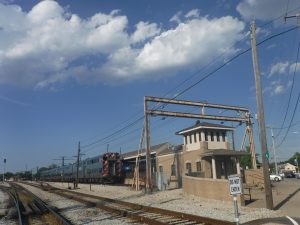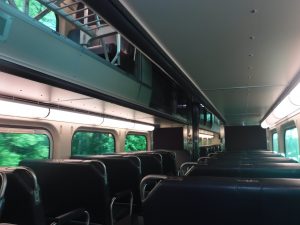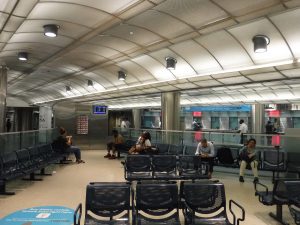Metra proposes major South Side service overhaul
By Igor Studenkov For Chronicle Media — July 10, 2017
111th/Pullman Metra station, which got a number of improvements in the fall of 2016, will see trains stopping once every hour rather than once every two hours under the proposed new Metra Electric schedule. (Photo by Igor Studenkov/for Chronicle Media)
Metra is proposing a major overhaul of the Metra Electric Line, which would mean more travel options for some passengers and fewer options for others.
According to an official statement posted on the transit agency’s website, it is looking to rearrange service based on demand.
The stations serving Hyde Park and Kenwood would see more trains, as would a number of neighborhoods further south. But South Shore and South Chicago neighborhoods would both see declines, as would portions of West Pullman and Roseland neighborhoods on the city’s edge.
Metra is currently soliciting public feedback, and a final version of the new schedule is expected to take effect some time later this summer.
Metra Electric Line services much of Chicago’s South Side east of he Dan Ryan Expressway, as well as many suburbs directly south of the city. It starts at the Millennium Station under Millennium Park and travels south, serving McCormick Place, Bronzeville, Kenwood and Hyde Park. At 63rd Street, it’s South Chicago branch splits off and heads east, then south, serving South Shore and South Chicago neighborhoods.
The main branch continues south, serving Greater Grand Crossing, Chatham, Avalon Park, Calumet Heights, Burnside, Rosemoor, Pullman and West Pullman neighborhoods. At 115th Street, the Blue Island branch splits off and travels west, serving Far South Side’s West Pullman and Roseland neighborhoods, as well as the suburban city of Blue Island, stopping across the street from Rock Island District’s Blue Island station. Meanwhile, the main branch continues past the city limits into the south suburbs until it reaches University Park.
The line is different from other Metra lines in many respects. It is the only line in the system where trains use electric power rather than diesel locomotives. It is also the only line to have high-level platforms rather than ground-level platforms.

Metra Electric Line’s Blue Island station will no longer see any Saturday service under the proposed new schedule. (Photo by Igor Studenkov/for Chronicle Media)
The main branch has four tracks that are completely separate from tracks used by freight and Amtrak trains, so there is more flexibility to move trains and fewer causes for delays. The South Chicago branch has a distinction of being the only Metra branch line to fall entirely within Chicago city limits. Metra Electric isn’t the only line that has flag stops, but it has more of them than all of the other lines combined. Most notably, all of the stops between 63rd and 115th Street are flag stops.
While most lines have district weekday and weekend schedules, the current Saturday and weekday schedules only have a few differences, with most trains running on all six days. The Sunday schedule is different, with reduced service frequency and no service on the Blue Island branch at all. If taken together, all three branches have more frequent service than any other line.
The Metra’s proposal will alter that schedule in many important respects.
For the Blue Island branch, the Saturday service would be eliminated completely. The first weekday train would leave Blue Island at 5 a.m. instead of 4:30 a.m.
While the rush our schedule would get minor tweaks while retain the same service frequency, the number of non-rush hour trains would be cut back, with 9:18 a.m. and 11:18 a.m. trains replaced with a single 10:18 a.m. train; and the 3:18 p.m. and 4:28 p.m. replaced with a 4:18 p.m. train. And while under the current schedule, the last train leaves Blue Island at 11:43 p.m., all of the trains after the 7:41 p.m. train would be cut altogether.

The 6:43 p.m. Chicago-bound Blue Island branch train only had two passengers as it left Blue Island station. (Photo by Igor Studenkov/for Chronicle Media)
The schedule for trains traveling from Millennium Station to Blue Island would be largely the same save for some time adjustments, but the reduction of the evening service applies to those trains, too. Under the current schedule, the last train arrives in Blue Island at 12:25 a.m., while the new schedule would have the last train arrive at 8:23 p.m.
On the South Chicago branch, the weekday service would also start later, with first train at 5:20 a.m. rather than 4:30 a.m.
The number of off-peak trains would also reduced, albeit not as severely. While the last train currently leaves 93rd/South Chicago station at 12:09 a.m., the 9:09 train would now leave the station at 9:40 p.m., and the three later trains would be cut. Unlike the Blue Island branch, the number of off-peek daytime trains remains largely the same. 4:21 p.m. and 4:48 p.m. train would be replaced with a 4:50 p.m. train.
As with the Blue Island branch, the outbound weekday schedule would remain largely the same, save for the later start and earlier end of service.
Meanwhile, the Saturday schedule would be more significantly reduced. The number of morning trains would drop from five to three, and the service would start later, with the first train leaving at 5:59 a.m. rather than 4:53 a.m.
Under the current schedule, daytime trains would run every hour, with service frequency increasing to once very 20-30 minutes between 4 and 6 p.m. The new schedule would standardize the service frequency to once an hour. The trains would run later into the evening than they would under weekday schedule, with the last train leaving at 11:59 p.m.
Similar pattern would apply to the service to South Chicago, with the number of trains running between 5:30 and 9 a.m. reduced from six to three, and the number of 4-6 p.m. trains reduced from four to two.

: Blue Island branch riders will be able to take advantage of Pace and CTA buses on Saturday, but they’re slower. (Photo by Igor Studenkov/for Chronicle Media)
The branch’s Sunday schedule would remain similar it terms of overall number of trains, with an average wait time of once every two hours.
For the University Park branch, rush-hour trains would see some shifts in schedule, even if the overall number of trains would remain similar, and the evening trains wouldn’t see any changes at all. But the schedule would beef up a number of trains traveling between 115th street’s Kensington station and Millennium Station, adding an 11:33 a.m. train and 3:33 p.m. train.
Under the current schedule, most trains traveling between University Park and Millennium station don’t make stops between Kensington and 63rd Street, while most Blue Island branch trains do. This means that weekday off-peak trains only stop there once every two hours. The addition of the two Kensington-Millenimum Park trains, as well as changes to the Blue Island branch schedule, ensure that trains would stop there once every hour.
As with the South Chicago branch trains, the number of Saturday University Park trains would be pared down, with trains making trips once every hour. Kensington trains would be added on Saturday as well, leaving the station at 9:42 a.m., 11:42 a.m., 1:42 p.m. and 3.42 p.m. Like their weekday counterparts, they would be making stops between 115th and 63rd streets.
As indicated by the Metra statement, together, the new schedule was designed to increase the number of trains traveling between 63rd Street and Millennium stations. The current schedule has a number of local and express trains running through that segment, and not all of them stop at every single station. This means that major stations such as 57 th -58 th -59th street station and Museum Campus station get more service than others. And, in both cases, the schedule isn’t consistent, with wait time between trains being anywhere between 10 minutes to an hour.
The new schedule creates a more consistent pattern for the three stations that serve Hyde Park, with trains stopping once every 20 minutes during daytime off-peak hours and between 7-10 minutes during rush hour. The 47th Street station, which serves Kenwood, currently gets trains roughly once every hour during off-peak hours, the trains would stop an average once every half hour. The service along 27th Street station, which serves Bronzeville, would largely remain the same.
According to Metra spokesman Michael Gillis, this would mark the most significant schedule change the line has since in over two decades.
“There have been several minor tinkers to the schedule over the years — things like adjusting departure times for certain trains, adding times between stops or splitting trains to relieve overcrowding,” he said.” The last major revision was in 1996, but that was just for the Sunday schedule. Before that, there was a major revision in 1989 that eliminated the Blue Island Branch Sunday service and made other changes “
In an official statement, Metra CEO Don Orseno described the new schedule as an attempt to better use the existing resources, beefing up service where there is more demand and eliminating trips that don’t get much ridership.
“We need to do something to stem the loss of ridership on the Metra Electric Line, which has been declining for years despite the fact that the line has the newest cars and most scheduled trains on our system,” he sated. “This new schedule is an effort to make the best use of our existing resources by scheduling our trains in a more efficient way and enhancing service without impacting our budget.”
The statement indicates that the line’s overall ridership declined by nearly 14 percent in the past six years, and that it represents 61 percent of the systemwide ridership decline during that span of time.

Passengers wait for Metra Electric trains at the Millennium Station. (Photo by Igor Studenkov/for Chronicle Media)
As previously reported by the Chronicle, according to the 2016 State of the Metra System report, Hyde Park stations attract almost as much ridership as Chicago downtown stations during rush hour. It would also increase ridership to Chicago State University, which is directly served by the 95th Street station. As the Metra statement notes, it would also increase service to 111th/Pullman station, which is located at the heart of the neighborhood’s historic district. The area was designated a national movement in February 2015, and Metra has been working to capitalize on it, rehabbing the station in October 2016.
The statement notes that South Chicago and Blue Island branches both saw more dramatic ridership declines than the rest of the line, dropping by 11.2 percent and 17.5 percent, respectively. The Blue Island branch ridership was particularly low on Saturdays, with “less than a hundred” riders taking it per day.
Steve Marshal, of Calumet Park, works at Elsewhere Comics & Collectibles, a Blue Island comic book store located two blocks west of the Metra Elctric station. While he said he only used the Blue Island branch occasionally, he didn’t think it was a good idea to get rid of the Saturday service.
“I dislike how it doesn’t run on Sundays in the first place,” Marshal said. “[If the Saturday service is cut], it’s probably going to be like it is on Sunday — you have to take the bus to 115th. It’s super inconvenient.”
He said that he had seen Blue Island riders taking it to festivals in downtown Chicago during the summer. While Rock Island District Line goes from Blue Island to the Loop as well, the Metra Electric gets riders directly to Grant Park and the Museum Campus.
Marshal also said that he personally likes Metra because it’s faster than the combination of CTA buses and trains he would need to take to make the same trip.
Jose Lopez, of University Park, said he took the main line to work — but he still felt cutting service to other branches was a bad idea.
“I think they should keep the schedule as it is,” he said. “I understand where they’re coming from, about cuts and budget, but there are a lot of people who need it. I see a lot of people taking the train on Saturdays, because I work on Saturdays.”
Lopez argued that, instead of cutting trips, Metra should use two-car trains instead of four-car and six-car ones on less-used branches.
Devin Link, of Harvey, said he reviewed the schedule changes a week earlier, and he was mostly OK with them.
“It would help with getting people out of the city center and move them effectively into the suburbs, and lowers parts of Chicago,” he said. “I think they should add more times on weekends, but I know that they don’t have the ridership.”
At the moment, the changes are not quite finalized. Metra is holding a series of public meetings — one for each major segment — to get rider feedback. The South Chicago branch meeting was held on June 19 at the South Shore Cultural Center (7059 S. South Shore Drive), while University Park branch meeting will be held on June 20 at Flossmoor Village Hall (2800 Flossmoor Road). The Blue Island branch meeting will be held on June 21 at the Blue Island City Hall (2434 Vermont St.), while the main line meeting will be held on June 22 at University of Chicago’s Polsky Exchange (1452 E. 53rd St., 2nd Floor). All meetings are held between 4-7 p.m.
All of those meetings took place after this article’s print deadline.
“Metra will consider all comments before finalizing the schedule, with a goal of implementing the new schedule later this summer,” Gillis said.
Free subscription to the digital edition of the Cook County Chronicle
Read the current issue of the Cook County Chronicle
— Metra proposes major South Side service overhaul —



